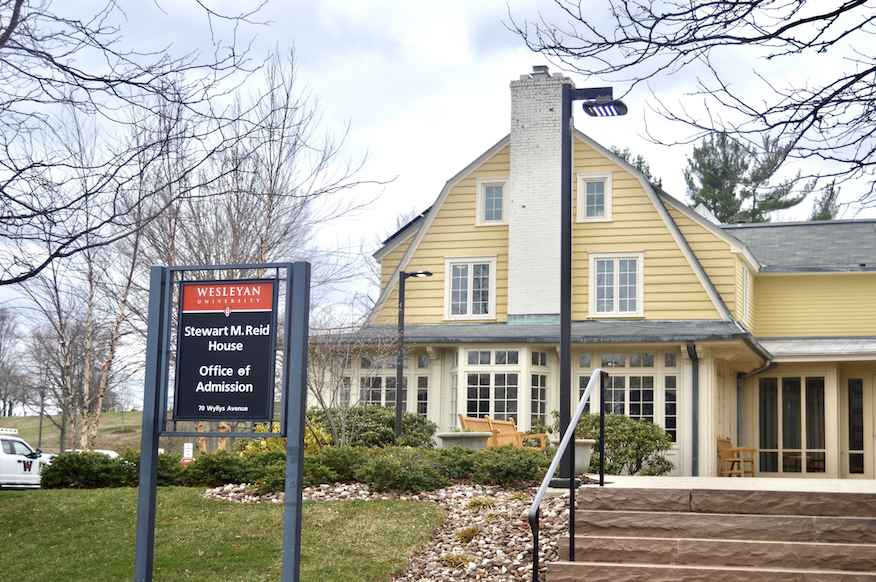
c/o Alexandra Turtil
On Saturday, Feb. 10, Wesleyan University released the results for the class of 2028 Early Decision II (EDII) applicant pool. There were 135 students admitted through the process, and no more offers of admission will be extended until the release of Regular Decision results later in the spring.
While the Office of Admission declined to share statistics of selectivity rates with The Argus, Vice President & Dean of Admission and Financial Aid Amin Gonzalez ’96 noted that Wesleyan University received the largest amount of Early Decision applications ever this cycle. Given that the amount of admits was on par with previous years of Early Decision, this year was likely the most selective in the history of Wesleyan University’s Early Decision process.
This year’s application cycle marked a shift in college admissions nationwide as the first admissions cycle since the Supreme Court’s decision to end race-based affirmative action in higher education institutions. The decision prompted some universities to explicitly invite students to write about their cultural and/or ethnic background in the application; Wesleyan University, however, declined to do so.
“Since the Common App, Apply with Scoir, and QuestBridge application essay prompts provide space/opportunity for students who are so inclined to speak to their backgrounds, lived experiences, and identities, we deliberately decided not to introduce or require a supplemental essay in the wake of the SCOTUS ruling against the consideration of race as status in selection,” Gonzalez wrote. “[Wesleyan University] remains committed to enrolling a dynamically diverse student body while complying with the Supreme Court’s ruling against Affirmative Action.”
Wesleyan made its own headlines last summer when it ended legacy preference in admissions, joining a small group of liberal arts schools such as Amherst College and Pomona College. In an all-campus email sent on Jul. 19, 2023, President Michael Roth ’78 acknowledged that this decision was unlikely to lead to a significant shift in Wesleyan University’s legacy admission rate.
“An applicant’s connection to a Wesleyan graduate indicates little about that applicant’s ability to succeed at the University, meaning that legacy status has played a negligible role in our admission process for many years,” Roth wrote.
In recent years, admitted classes have been made up of seven to eight percent legacy students on average, and legacy students had much higher acceptance rates than non-legacy students. According to 2021 admissions data, students with parent legacy status had an acceptance rate of 49.7%, far higher than the general acceptance rate of 19.3%.
In an email sent to The Argus, Gonzalez wrote that the effects of the SCOTUS decision and University policy changes were not yet known.
“Wesleyan continues to invite applicants to bring their full authentic selves to the application process and values multi-generational representation on campus but doesn’t confer any automatic benefits or preferences based simply on status or affiliation,” Gonzalez wrote. “Since we don’t know either the racial/ethnic composition of our pool of applicants or which have alumni relatives at this time, the impacts of the SCOTUS ruling and our legacy announcement are not entirely clear…once the Class of 2028 is settled, we will be better positioned to assess changes in applicants’ behavior and admission outcomes.”
While the racial demographics and legacy status of the Class of 2028 are not yet known, other demographic information gives clues into the composition of the class.
More than 75 percent of EDII admits had studied math through calculus, taken biology, chemistry, and physics, and learned a foreign language for at least four years. These figures are in line with past years of admission. One noticeable difference was that only 37% of admitted students had their standardized test scores considered, a sharp decline from the 58% of admits in the Class of 2027 who shared this information.
During the COVID-19 pandemic, a significant majority of universities in the United States became test-optional, allowing applicants to decline to share their standardized test scores; however, colleges such as Yale University and Dartmouth College have recently announced plans to reinstate these requirements.
In terms of socioeconomic demographics, 50% of the EDII admits for the class of 2028 applied for financial aid, ten percent are international students, and nine percent are first-generation college students. While the figures for international students and first-generation students are slightly lower than in previous years, the financial aid rate is higher than any of the previous five years, where between 42% to 48% of first-year students applied for financial aid.
With the Early Decision rounds now complete, the Office of Admissions will now turn its attention to Regular Decision. If current trends hold, this will be one of the most competitive classes in Wesleyan University’s history. Despite the recent changes to admission policies, Gonzalez is positive that the Class of 2028’s demographic background will remain diverse.
“The foundation of the Class of 2028 is well-prepared academically, socio-economically and geographically diverse, and poised to contribute significantly to the vitality of the Wesleyan community,” Gonzalez wrote.
Silas Bishop can be reached at sbishop@wesleyan.edu.
Miles Pinsof-Berlowitz can be reached at mpinsofberlo@wesleyan.edu.
-
NeuroTest where to buy